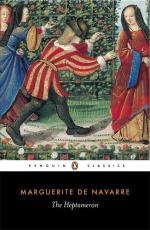Ladies, said Simontault, I have been so poorly rewarded for my long service, that to avenge myself upon Love, and upon her who treats me so cruelly, I shall be at pains to make a collection of all the ill turns that women hath done to hapless men; and moreover I will relate nothing but the simple truth.
In the town of Alencon, during the lifetime of Charles, the last Duke,(2) there was a Proctor named St. Aignan, who had married a gentlewoman of the neighbourhood. She was more beautiful than virtuous, and on account of her beauty and light behaviour was much sought after by the Bishop of Sees,(3) who, in order to compass his ends, managed the husband so well, that the latter not only failed to perceive the vicious conduct of his wife and of the Bishop, but was further led to forget the affection he had always shown in the service of his master and mistress.
2 The Duke Charles here
alluded to is Margaret’s first
husband.—Ed.
3 Sees or Seez, on the Orne, thirteen miles from Alencon, and celebrated for its Gothic cathedral, is one of the oldest bishoprics in Normandy. Richard Coeur-de-Lion is said to have here done penance and obtained absolution for his conduct towards his father, Henry II. At the time of this story the Bishop of Sees was James de Silly, whose father, also James de Silly, Lord of Lonray, Vaux-Pacey, &c, a favourite and chamberlain of King Louis XII., became Master of the Artillery of France in 1501. The second James de Silly—born at Caen—was ordained Bishop of Sees on February 26th, 1511; he was also Abbot of St. Vigor and St. Pierre- sur-Dives, where he restored and beautified the abbatial church. In 1519 he consecrated a convent for women of noble birth, founded by Margaret and her first husband at Essey, twenty miles from Alencon, the ruins of which still exist. A year later Francis Rometens dedicated to him an edition of the letters of Pico della Mirandola. He died April 24th, 1539, at Fleury-sur-Aiidelle, about fifteen miles from Rouen, and was buried in his episcopal church. (See Gallia Christiana, vol. xi. p. 702.) His successor in the See of Sees was Nicholas Danguye, or Dangu (a natural son of Cardinal Duprat), with whom M. Frank tries to identify Dagoucin, one of the narrators of the Heptameron.—L. and Ed.
Thus, from being a loyal servant, he became utterly adverse to them, and at last sought out sorcerers to procure the death of the Duchess.(4) Now for a long time the Bishop consorted with this unhappy woman, who submitted to him from avarice rather than from love, and also because her husband urged her to show him favour. But there was a youth in the town of Alencon, son of the Lieutenant-General,(5) whom she loved so much that she was half crazy regarding him; and she often availed herself of the Bishop to have some commission intrusted to her husband, so that she might see the son of the Lieutenant, who was named Du Mesnil, at her ease.




